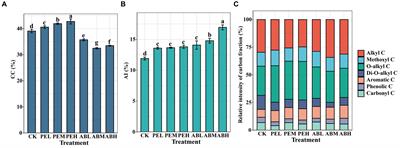Changes in Soil Organic Carbon Components and Microbial Community Following Spent Mushroom Substrate Application

While spent mushroom substrate (SMS) has shown promise in increasing soil organic carbon (SOC) and improving soil quality, research on the interplay between SOC components and microbial community following the application of diverse SMS types remains scant. A laboratory soil incubation experiment was conducted with application of two types of SMSs from cultivation of Pleurotus eryngii (PE) and Agaricus bisporus (AB), each at three application rates (3%, 5.5%, and 8%). Advanced techniques, including solid-state 13C nuclear magnetic resonance (NMR) and high-throughput sequencing, were employed to investigate on SOC fractions and chemical structure, microbial community composition and functionality. Compared to SMS-AB, SMS-PE application increased the relative abundances of carbohydrate carbon and O-alkyl C in SOC. In addition, SMS-PE application increased the relative abundance of the bacterial phylum Proteobacteria and those of the fungal phyla Basidiomycota and Ascomycota.
The relative abundances of cellulose-degrading bacterial (e.g., Flavisolibacter and Agromyces) and fungal genera (e.g., Myceliophthora, Thermomyces, and Conocybe) were increased as well.
The application of SMS-AB increased the aromaticity index of SOC, the relative abundance of aromatic C, and the contents of humic acid and heavy fraction organic carbon. In addition, SMS-AB application significantly increased the relative abundances of the bacterial phyla Firmicutes and Actinobacteria. Notably, the genera Actinomadura, Ilumatobacter, and Bacillus, which were positively correlated with humic acid, experienced an increase in relative abundance. Functional prediction revealed that SMS-PE application elevated carbohydrate metabolism and reduced the prevalence of fungal pathogens, particularly Fusarium.
The application of high-rate SMS-AB (8%) enhanced bacterial amino acid metabolism and the relative abundances of plant pathogenic fungi. Our research provides strategies for utilizing SMS to enrich soil organic carbon and fortify soil health, facilitating the achievement of sustainable soil management.
Read the full article at the original website
References:
